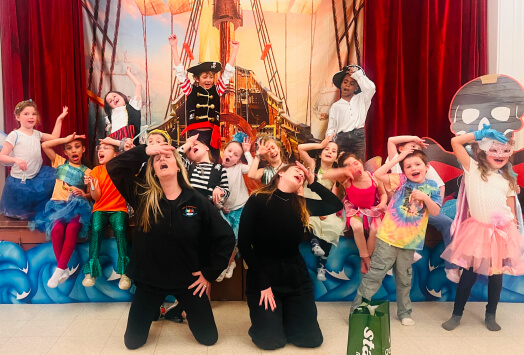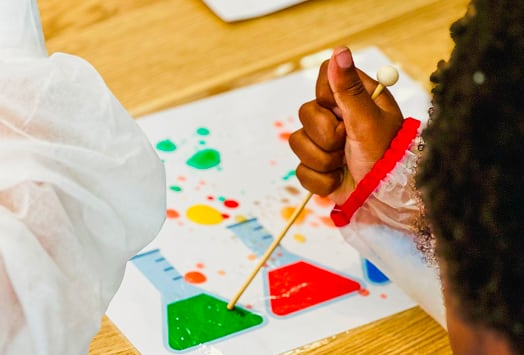Teaching is a great way to share your expertise with a new generation of learners. If you are passionate about the culinary arts, then you might want to start a business teaching cooking and baking classes for kids.
There are so many benefits of cooking with kids, including improved language and math skills, increased confidence and independence, and better patience and teamwork. Plus, research shows that cooking programs positively influence food preferences, attitudes, and behaviors for children who participate. Therefore, teaching kids to cook is a rewarding experience for both yourself as an instructor as well as your students as they grow.
To help you hit the ground running as you prepare to turn your passion into a children’s activity business, we’ve outlined everything you need to know to start teaching kids to cook. In this article, you’ll find tips for teaching classes in-person and virtually from your home, cooking activities for preschoolers and toddlers, easy recipes for kids, and kids cooking class ideas that are fun and informative. And if you want to learn how to write a curriculum, check out our guide!
- How to teach cooking classes for kids
- ~Can I teach cooking classes in my home?
- Cooking activities for preschoolers & toddlers
- Kids cooking class ideas
How to teach cooking classes for kids
As you prepare to start teaching kids to cook, you need to think about how to help children understand cooking. Things that might come naturally to you will be more difficult for little ones to understand. Here is some of our best advice on how to teach cooking classes tofor kids.
Think about child development
Cooking classes can be enjoyed by children of all ages as long as the lessons are tailored to each age group. Toddlers (aged 1-4) may be able to findi, measure, and mix ingredients, but adult supervision will be necessary for other parts of the lesson. As children get older, they will be able to manage more of the lesson on their own. Finally, if you are looking to teach preteens and teens, let them be independent and explore their creativity in the kitchen.
Buy the right gear
Did you know that they make kitchen utensils specifically for little hands? Brands like Curious Chef offer child-friendly cooking and baking sets, including knives, bowls, utensils, oven mitts, and more. Having the right, age-appropriate products for your students will help them feel more comfortable in the kitchen and ensure you are providing a safe environment for them to learn. For more help on where to buy supplies for teaching kids, check out our guide.
Prepare each step in advance and with the class
Before your class, make sure that you break down your recipe into steps. For example, if you are making pizza in your class, create a recipe that outlines how to make or prepare each element of the pizza: dough, sauce, cheese, toppings. Then, as you prepare for the class, create each step beforehand so you can show your students what it should look like. Then, make it with them again in the class using your example as a guidepost.
Model good health practices
Children learn by doing and mimicking. At the beginning of every class, wash your hands with your students. If you are cutting meat, clean the cutting board before using it again. Clean up as you go and your students will learn best practices for being healthy and keeping a sanitary kitchen. Remember: they are learning from you even when you’re not actively teaching!
Eat what you’ve created together
When children take cooking classes and get involved with meal preparation, they are more likely to try new things and pick healthier options, according to research. To help ensure they get this benefit from your cooking classes, make sure you allow time for the class to eat their creation together. Children will enjoy the fruits of their labor (literally!) and might find a new favorite food along the way!
Can I teach cooking classes in my home?
If you want to teach in-person cooking classes, you will need to check with your local health department and county clerk to see if you need a commercial kitchen, license, and/or permit. However, if you are looking instead to teach cooking classes in your home virtually, you will just need a general business license to start your organization.
When you schedule your classes, make sure that parents are aware of the recipe so they can purchase the necessary ingredients. You might also want to make sure that they have child-friendly supplies and/or that an adult will be there to supervise. Also, be sure to inform them in advance if they will need to participate in the class. On your end, you should always have the ingredients in your house and make the recipe along with your class. For successful virtual learning and livestreaming on Zoom, check out our guides.

Cooking activities for preschoolers & toddlers
Teaching kids to cook should be informative, but most importantly, fun! When you are working with little children, keeping them entertained is one of the best ways to keep them engaged. Because they likely cannot participate in all of the preparation, finding fun cooking activities for preschoolers & toddlers is a great way to make sure they have fun and learn at the same time.
- Vocabulary games. As you go through a recipe, teach the toddlers the names of the items you are handling. If you are making dough, talk them through the ingredients (flour, sugar, yeast, oil). If you are making cookies, teach them the words for the process (pouring, mixing, baking). Towards the end, create a game by asking them to repeat what they’ve learned. Playing games helps enhance classroom learning and keeps children engaged.
- Math games. Cooking incorporates math and is a great way to introduce younger children, like toddlers, to basic concepts in a fun and rewarding way. As you cook or bake with the little ones, have them count the ingredients or the steps in the recipe. If you are making apple pie, let them go through the apple slices and count them. This is also a good time to teach them concepts like measurements and amounts: half, one-quarter, more, and less.
- Storytelling. As you go through the recipe, tell a story about what you are doing and making. Research shows that stories help children connect more to the lesson and help them develop empathy. Teach your students about the history of the dish they are making, the culture and location from which it originates, the ingredients they are using, or create a fictional story that will keep them on their toes. You can even bring recipes from their favorite books or movies to life! Try recreating the pork tamales from Coco or the namesake dish from Green Eggs and Ham.

Kids cooking class ideas
A great kids cooking class needs easy recipes and fun activities that children can be confident and comfortable mastering. If you are teaching 6 year olds, it is probably best to leave the creme brulee recipe in the folder. Instead, check out these great kids cooking class ideas, some inspired by our great Sawyer providers!
- All about appetizers: In this class, children will learn how to make some classic appetizers like deviled eggs, bruschetta, and hummus. This is a great class for a drop-in session or you can add it to a full semester course where they learn to make entrees and desserts in different sessions.
- Geography-focused: Create classes that focus on different geographic regions. In one class, children can make pad thai and Thai iced tea. In another, they can make gumbo and cornbread or baked ziti and caprese salad. These classes are great in a semester so children are able to experience a variety of cuisines and cultures over time.
- Themed classes: Look at the calendar and create classes around upcoming events. Before Thanksgiving you can teach a class about side dishes and before the Super Bowl you can focus on fun party snacks. These can be one-off classes one or two weeks before the event so that children can use the recipes later for their families.
- Baking and desserts: Teaching children how to bake is a great way for them to learn about math and science. Plus, when children can make their own sweets, they are less likely to reach for the processed stuff. You can do drop-in baking and dessert classes or a semester or camp.
- Lunch and snacks: In these classes, children can learn how to make interesting lunches and snacks to take with them to school. Some examples are soups & chilis, homemade snack mix, yogurt parfaits, and hearty salads. Children will love the independence they get from making their own meals for school. These classes would be great on their own or in a semester.
Get your editable cooking lesson plan template

Teaching kids to cook provides so many benefits for you, the children, and the adults in their lives! If you are looking for guidance on managing and running your children’s education and activity business, the team at Sawyer is here to help. We work with educators every day to save time on admin, spend more time in the classroom, and grow their businesses. See how we do it with a free trial or demo today.





















.png)












.avif)
.avif)
.avif)
.avif)




